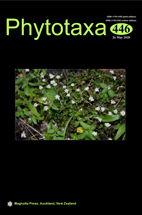Abstract
Chamaecrista is a monophyletic genus, comprises approximately 330 tropical species classified into six sections of which Chamaecrista sect. Absus is the largest of them with 190 species, four subsections, and 31 series. Series Paniculatae comprises seven species (13 taxa) mainly distributed in the Brazilian Savanna and has been pointed as a paraphyletic group in a preliminary study about Chamaecrista. We propose a phylogenetic reconstruction of Paniculatae in order to test its monophyly based on a larger sample, to verify its relationships with other series, and to better define its systematic position in the genus. We sampled 74 taxa: 68 species of Chamaecrista (including all species of the series Paniculatae), six of Senna, and one of Cassia. Phylogenetic relationships of this taxa were explored using Maximum Parsimony (MP) and Bayesian analyses of nuclear ITS and plastidial trnL-trnF sequences, and the divergence time was estimate. Paniculatae emerge as a paraphyletic group in all analyses. Consequently, we are herein redefining the series Paniculatae in a monophyletic group with 13 morphologically well-defined species, divided into two genetically and geographically structured subclades. Divergence time analyses suggested that the clade Paniculatae, as defined here, originated ca. 6.2 million years ago, and had two main diversification events consistent with the recovered subclades. We propose the ranking of the varieties belonging to Ch. claussenii, Ch. orbiculata and Ch. rigidifolia at the level of species supported by morphological characteristics and large ranges of distribution, as well as phylogenetic relationships observed. We believe that our results enhanced the understanding both origin of the species of Paniculatae series, as well as of local species distribution in the Cerrado Biome.

